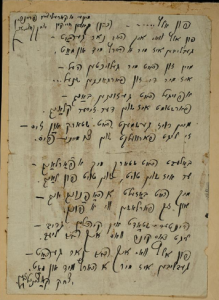Song of the Murdered Jewish People: Looking for the "Real" Yitzkhak Katzenelson

Dedicated to Khayke Kahan, "my friend from
Korelitz." "Of everything . . . / Of everything that
I once had / There remains to me a heart tired
and weary. . . ." Yiddish. RG 108, Manuscripts
Collection, F73.12. (YIVO)
Poet and playwright Yitzkhak Katzenelson (1885-1944) was known chiefly for his work in Hebrew before World War II, especially in Łódź, where he helped found Ha-Bamah ha-‘Ivrit (The Hebrew Stage) Theater Company. But when he was incarcerated in the Warsaw Ghetto, he turned to Yiddish poetry as a way of reaching more readers. In 1942, his wife and two younger sons were deported to the Treblinka death camp. He and his older son joined the Jewish resistance in the ghetto and participated in the Warsaw Ghetto Uprising. In May 1943, as the German razed the ghetto, he escaped to the Aryan side of the city and managed to obtain a Honduran identity certificate. This, however, did not save him. He and his son were incarcerated in a detention camp for foreigners in Vittel, France, and from there, deported to Auschwitz, where they were murdered.
Even during his imprisonment in Vittel, he continued to write poetry, some of which survived in hiding places or in the hands of trusted individuals. Among the poems he wrote as a prisoner was the lament Dos lid funem oysgehargetn yidishn folk (Song of the Murdered Jewish People), which would become his best-known work.
Now, two adjunct professors from the Philology Department of Jagiellionian University in Krakow have joined together in a project focused on this poem and on Katzenelson's life and work. Magdalena Sitarz is a specialist in the History of Literature and Yiddish Studies. She recently published Literature as a Medium for Memory. The Universe of Sholem Asch's Novels (Peter Lang 2013). Andrzej Pawelec specializes in Philosophy, Linguistics and Translation Theory. He has recently published articles on Emily Dickinson's poetry in Polish translations.
Sitarz and Pawelec wrote to Yedies editor Roberta Newman with more information about their project:
Our interest in Katzenelson's work was sparked off two years ago by a German translation of Dos lid funem oysgehargetn yidishn folk. A German translation--a labor of love--was published in 1994 by Wolf Biermann, a German bard and a Jew. It bears the strong imprint of his views and aesthetic commitments, making Grosser Gesang vom ausgerotteten jüdischen Volk no less a work of Biermann's than Katzenelson's. Magda was greatly impressed by the expressive power and poetic craftsmanship of this rendition while Andrew had his doubts concerning its fidelity. We soon found out that Magda's response had been shared by the German public. Thanks to Biermann's efforts, Katzenelson has become more popular in Germany than anywhere else in the world (with the possible exception of Israel, where his memory is preserved by Ghetto Fighters' House, the Itzhak Katzenelson Holocaust and Jewish Resistance Heritage Museum, Documentation and Study Center). In an attempt to sort out our mixed feelings we have decided to look for the "real" Katzenelson.
The goal first part of our project is to produce a transcript of Dos lid according to YIVO transliteration rules and make it available online until the end of 2014. In this way, we hope to foster discussion about its impact on contemporary readers, especially among those for whom the Yiddish alphabet constitutes an obstacle. From a scholarly perspective, we would like to take account of textual variants in order to decide whether a "variorum edition" would be a good idea. We have contacted Professor Yechiel Szeintuch who did much work on Katzenelson's manuscripts in the 1980s, and this line of research remains a possibility.
Our main goal is to study the reception of Dos lid after its publication in 1945. We want to gather and catalogue all existing editions and translations as a preliminary step. Subsequently, we would like to produce a monograph outlining the reception of Katzenelson's requiem in different countries. We are well aware that this is a challenging task which requires international cooperation. We are currently applying for grants to finance a conference in Poland which would gather scholars who could contribute to the project. We are planning to organize it in 2016 in Łódź, the textile industry city in which Katzenelson spent almost all his life.
We have discussed this project with the Museum of Łódź. We hope that it will be possible to organize concurrently an exhibition of archive materials on Katzenelson and his family, who ran several schools in Łódź before the Second World War. We also hope to involve in the project the Ghetto Fighters' House Museum which has the largest collection of archival materials on Katzenelson. In this context, we believe that a comprehensive biography of Katzenelson in English is sorely needed. We will probably not be capable of accomplishing this task on our own but we hope that we can collect enough biographical material to take up this challenge with help from others.
Read the entry on Yitzkhak Katzenelson in the YIVO Encyclopedia of Jews in Eastern Europe.
Read more about Katzenelson and Dos lid funem oysgehargetn yidishn folk at culture.pl.